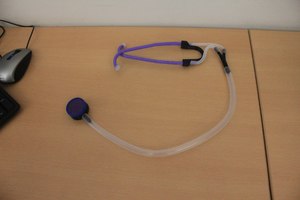Part 2. How 3D Printing Stethoscopes can Make the World a Better Place?
A stethoscope is a medical tool that is fundamental in order for medical professionals to characterize heart and lung sounds. This Glia stethoscope model has been tested by medical professionals, who have compared it to the sound quality of the industry leading Littmann Cardiology 3 stethoscope. It is a viable option in developing countries that may have limited access to medicla supplies.
3D printed stethoscope made by Alejandra Guzman for DHN 3300 UOttawa. It was based on the one made by Glia Project project for Open Medical Devices in 2015, Art. no. 2017.0002 Ingenium: Canada's Museums of Science and Innovation.
This 3D innovation has been used in the field of medical emergencies in Gaza, which has proved its effectiveness and capacity. As a medical tool that has been developed for a subsidized cost for use in developing or war stricken counties effectively conveys merely that. It is a piece that has come out of development due to the issues surrounding the cost and difficultly of obtaining commercially available products. This is typically due to financial issues, which can be a result of political problems or civil wars. Producing a low cost, but high quality medical tool for a fraction is revolutionary in cases such as Gaza. In places like Gaza, many doctors do not use stethoscopes and may rely solely on their ears to chest method.
The stethoscope being 3D printed is significant in conveying status and ideas, as an area defined by its conflict there is a shortage of medical supplies that are essential in an area where there are high casualties. In developing areas, it is hard to financially afford medical supplies, especially without the help of donors. It is revolutionary to be able to make low costing stethoscopes with only a few materials. It conveys development within this area to be able to assemble this 3D printer and create a stethoscope. Dr. Loubani has furthered his ideas with 3D technology by developing other medical supplies such as the pulse oximeter and the electrocardiogram PCB design.
The use of a 3D printer in a developing country is another important aspect, as it provides technological progress as there is a digital divide. Being able to train individuals from that developing country to assemble and operate a 3D printer is tremendous. Through large organizations and donor countries often focus on helping social aspects of that country, rather than technological infrastructures. Developing countries then lag further behind, but with the advancement of 3D printing medical tools to reduce costs may lead to more support in these areas. This is beneficial as there are many instances as to why hospital or doctors in developing countries may not be able to access medical tools and being able to produce them within the area is crucial in circumstances such as Gaza.
The Reality of 3D Printing in Developing Countries
Although 3D printing would be a great progressive move in developing countries, there are obstacles to it. The digital divide that exists between developed countries and developing countries makes access to STL files through the lack of internet impossible. There is also obtaining the technology in order to print these files, which include a 3D printer, filament, and a computer. These items can be found when provided, but for rural areas that do not have access are at a disadvantage. When there is accessibility to technology, people have tremendous benefits and can ignite their own creativity to improve their living conditions.
Although it would seem difficult to not only struggle with achieving these printed parts, clear tubing may be seen as a problem as well. In reality, Dr. Loubani choose silicone tubing because of Coca Cola. Funny, but it was genius as his explanation behind it is that Coke machines are everywhere and that it could be cannibalized from those machines (Western University, 2018). I think that it is a challenge in developing countries, but certainly possible with the right mindset.
